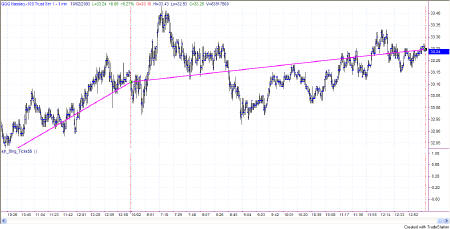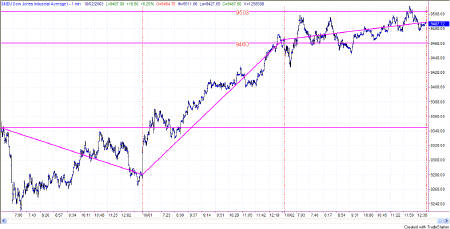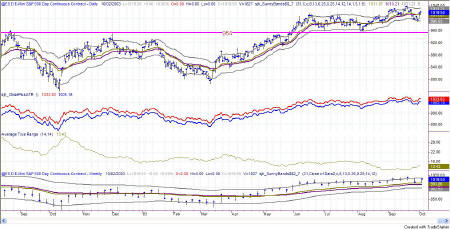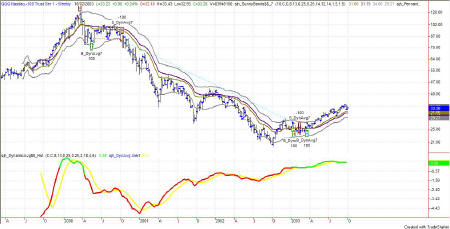
The Sunny Side of the Street
TECHNICAL ANALYSIS EDUCATION: EXPLAINED AND DECIPHERED FOR NEW AND
VETERAN TECHNICAL ANALYSTS ALIKE.
THURSDAY EVENING -
Oct 02, 2003
Archives of Past
Commentaries . How Did We Do?
Weekend Stock Picks --
CLICK HERE
Looks like no one was interested in real-time chatting, so I've removed the link. Anyone interested in posting comments or questions to the bulletin board (not real-time) may click here.
I am conducting two seminars in January, if enough interest is shown. The seminars are intense workshops in which we not only follow a strict and intense agenda, but in which we take your specific questions and problems and work them into the content of the workshop. You send me your issues well in advance of the seminar and I tailor the discussions to address your issues. Only 15 people are allowed to come, and you'll be pleasantly surprised how much we cover in depth.
$56,893 in Stock Picks to date! Click Here to view.
Another sideways day from my view of Figure 1a. The open and the close weren't that far apart, and the action for the day was equally spread above and below the line. That makes for one tough day of trading!
The Dow pretty much played within the two horizontal lines I had drawn yesterday, at 9460 and 9503, with the high for the day being just above there at 9511. The only way to have played today was not to play at all, unless you are really good at scalping a few pennies at a time.
On the daily charts, prices are staying between the Sunny_Bands, which signals neutral, and today the ES climbed into the upper band range, which signals bullish. So, maybe tomorrow we will be in for a visit to the top band, which lies at 1031. The range for tomorrow should be between the close of today +/- 1ATR, which would be 1005.18-1033.83.
Yesterday we were looking at monthly charts, noticing the long-term pennant and ascending triangle formations. I concluded that the Monthly chart of the Dow was long-term bullish, but short-term bearish (over say the next 3-6 months) so we'll have to wait and see. In the meantime, I'm watching the 15-minute chart each day, and that's what I trade using the Sunny_Bands in conjunction with the PennantFinder and the SDMA histogram.
Now let's look a little closer in, and see what the weekly charts say about the intermediate term outlook.
The QQQ index began trading in March of 1999, so the data doesn't go any further back than shown in the chart above. The system shown (buy & sell arrows) is simply my dynamic average selling and buying on the crossovers--pretty simple. Due the the start-up time required on a moving average calculation, the first signal on the chart is the sell signal at the top of the move, on 3/24/2000. That signal is confirmed by the crossover of the SDMA Histogram earlier, on Feb 11, 2000, and on 4/14/2000 by the close below the middle Sunny_Band.
On 5/19/2000 a buy signal is given by the DMA, but not confirmed by the SDMA Histogram, so while a trader might want to trade it, the investor and planner would ignore this signal. Further, there is no close above the Sunny_Band midline until 7/14/2000, when the QQQ closes just barely above the line, at 100.19. From that close we wait for a close higher than it to be stopped into the trade, and that never happens. So, the buy signal gets ignored.
The sell signal comes again on 10/13/2000 (see what I told you yesterday about Octobers?) and it is immediately confirmed by the SDMA Histogram. Furthermore, price is below the midline, and drops lower than the entry signal price, and we would be stopped into the short trade.
The Dynamic_Average stays in sell configuration (purple line on top of the gold line--slow average on top of fast average) until 11/29/2002, when the configuration changes. Also at that time, price touches the top Sunny_Band, and we would take profits and get out to stand on the sidelines and wait for a new signal.
The SDMA_Histogram goes into buy configuration on 8/16/2002, but that is too early to take the signal, as price is still below the midline and still falling.
On 11/1/2002, price crosses the midline, and we would set a stop to take use long at any close higher, which comes on the next bar. In this instance, we don't wait for the DMA to signal long, as the SDMA_Histogram is already long and 2 out of 3 is a good enough vote. Until present, price has continued to hold above the bottom band--and for the most part has held above the middle band, and has continued to move upward, even if sometimes slowly. So, on the weekly charts, everything still says bullish.
Attractor: a level to which prices seem to be drawn, like a magnet. Usually these are lines of support or resistance from previous highs and lows, but can also be an important level on an indicator, or the edge of a Sunny_Band.
RSI: Relative Strength Index (TradeStation function)
SDMA: Sunny's Dynamic Moving Average (proprietary)
Sunny_Band: Sunny's Dynamic Moving Average plus 1.5 ATR and minus 1.5 ATR, creating a band on either side of the SDMA.
This commentary is meant only for EDUCATIONAL PURPOSES. It is to help you see how a Technical Analyst reads the signs in the markets.
Stay sharp and on your toes. Moves can reverse on a dime, anytime. Let the market speak to you. If the market is going down, by golly ignore my commentary from the night before and know that the market is going down.
RULES OF THUMB:
0. I keep the chart in Figure 1a on each day's commentary simply to illustrate how much in tandem the 4 indexes I watch actually are. For this reason, I don't always comment on every index. Analysis of one speaks highly for the same analysis for each of the other indexes.
1. When price is pushing the upper Sunny_Bands upward and then eases off and moves back toward the midline, it's time to take profits. If it starts moving up and pushing on the Sunny_Bands again, it's time to get back in. Likewise, if the market is pushing down on the lower Sunny_Band and eases off to move back to the midline, it's time to take profits from the short play.
2. Divergence of the RSI and price is another good time to take profits and wait for a breakout of price before taking a position.
3. When the exchange puts in curbs or trading halts on a large move down, it usually (not always) stops the downward motion. After the market reopens is a good time to take profits from your short position.
4. The market can't go nowhere forever. Eventually, who knows how long it will be, there will have to be a breakout-- one direction or the other.
5. This commentary is for educational purposes only, and is meant only to teach readers about my indicators, other technical indicators, and how I read them.
==<:>==
While it may be true that a picture is worth a thousand words, it is definitely not true that a picture deserves a thousand words.



